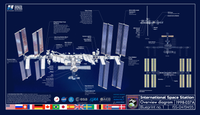Assembly of the International Space Station

The process of assembling the International Space Station (ISS) has been under way since the 1990s. Zarya, the first ISS module, was launched by a Proton rocket on 20 November 1998. The STS-88 Space Shuttle mission followed two weeks after Zarya was launched, bringing Unity, the first of three node modules, and connecting it to Zarya. This bare 2-module core of the ISS remained uncrewed for the next one and a half years, until in July 2000 the Russian module Zvezda was launched by a Proton rocket, allowing a maximum crew of two astronauts or cosmonauts to be on the ISS permanently.
The ISS has a pressurized volume of approximately 1,000 cubic metres (35,000 cu ft), a mass of approximately 410,000 kilograms (900,000 lb), approximately 100 kilowatts of power output, a truss 108.4 metres (356 ft) long, modules 74 metres (243 ft) long, and a crew of seven.[1] Building the complete station required more than 40 assembly flights. As of 2020, 36 Space Shuttle flights delivered ISS elements. Other assembly flights consisted of modules lifted by the Falcon 9, Russian Proton rocket or, in the case of Pirs and Poisk, the Soyuz-U rocket.
Some of the larger modules include:
- Zarya (launched 20 November 1998)
- Unity Module (launched 4 December 1998, also known as Node 1)
- Zvezda (launched 12 July 2000)
- Destiny Laboratory Module (launched 7 February 2001)
- Harmony Module (launched 23 October 2007, also known as Node 2)
- Columbus orbital facility (launched 7 February 2008)
- Japanese Experiment Module, also known as Kibo (launched in multiple flights between 2008–2009)
- The truss and solar panels are also a large part of the station. (launched in multiple flights between 2000–2009)
- Nauka (MLM-U) (launched 21 July 2021)
Logistics[]
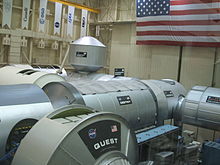
The space station is located in orbit around the Earth at an altitude of approximately 410 km (250 mi), a type of orbit usually termed low Earth orbit (the actual height varies over time by several kilometers due to atmospheric drag and reboosts). It orbits Earth in a period of about 90 minutes; by August 2007 it had completed more than 50,000 orbits since launch of Zarya on 20 November 1998.
A total of 14 main pressurized modules were scheduled to be part of the ISS by its completion date in 2010.[2] A number of smaller pressurized sections will be adjunct to them (Soyuz spacecraft (permanently 2 as lifeboats – 6 months rotations), Progress transporters (2 or more), the Quest and Pirs airlocks, as well as periodically the H-II Transfer Vehicle).
The US Orbital Segment was completed in 2011 after the installation of the Alpha Magnetic Spectrometer during the STS-134 mission. The Russian Orbital Segment assembly has been on an indefinite hiatus since the installation of the Rassvet module in 2010 during the STS-132 mission. The Rassvet module on the ISS right now was originally supposed to be the on-ground dynamic testing mock-up of the now-cancelled Science Power Platform. There is no dedicated science laboratory module on the Russian Orbital Segment as of 2020. The Nauka science laboratory module was originally supposed to be delivered to the ISS in 2007 but cost overruns and quality control problems have delayed it for over a decade. The current plan is for Nauka to be delivered in mid-2021 followed by the nodal module Prichal to be delivered in the third quarter of 2021. Nauka will have new crew quarters, life support equipment that can produce oxygen and water, and a new galley. There are plans to add 2 or 3 more modules that would attach to Prichal during the mid-2020s. Adding more Russian modules in 2021-25 will help the Zvezda module greatly because Zvezda's originally installed central command computers no longer work (three ThinkPad laptops are now the Zvezda's central command computers) and its Elektron oxygen generators are not replaceable and are way past their expiration date. In Russian modules all the hardware is launched with the equipment permanently installed. It is impossible to replace hardware like in the US Orbital Segment with its very wide 51 inch (105 cm) hatch openings between modules. This potential problem with the Zvezda was made apparent when in October 2020 the toilet, oven, and Elektron all malfunctioned at the same time and the cosmonauts onboard had to make emergency repairs.[3]
The ISS, when completed, will consist of a set of communicating pressurized modules connected to a truss, on which four large pairs of photovoltaic modules (solar panels) are attached. The pressurized modules and the truss are perpendicular: the truss spanning from starboard to port and the habitable zone extending on the aft-forward axis. Although during the construction the station attitude may vary, when all four photovoltaic modules are in their definitive position the aft-forward axis will be parallel to the velocity vector.[4]
In addition to the assembly and utilization flights, approximately 30 Progress spacecraft flights are required to provide logistics until 2010. Experimental equipment, fuel and consumables are and will be delivered by all vehicles visiting the ISS: the SpaceX Dragon, the Russian Progress, the European ATV and the Japanese HTV, and space station downmass will be carried back to Earth facilities on the Dragon.[5]
Columbia disaster and changes in construction plans[]

Disaster and consequences[]
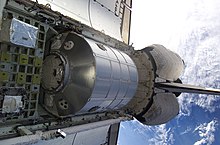
After the Space Shuttle Columbia disaster on 1 February 2003, there was some uncertainty over the future of the ISS. The subsequent two and a half-year suspension of the U.S. Space Shuttle program, followed by problems with resuming flight operations in 2005, were major obstacles.[citation needed]
The Space Shuttle program resumed flight on 26 July 2005, with the STS-114 mission of Discovery. This mission to the ISS was intended both to test new safety measures implemented since the Columbia disaster and deliver supplies to the station. Although the mission succeeded safely, it was not without risk; foam was shed by the external tank, leading NASA to announce future missions would be grounded until this issue was resolved.[citation needed]
Between the Columbia disaster and the resumption of Shuttle launches, crew exchanges were carried out solely using the Russian Soyuz spacecraft. Starting with Expedition 7, two-astronaut caretaker crews were launched in contrast to the previously launched crews of three. Because the ISS had not been visited by a shuttle for an extended period, a larger than planned amount of waste accumulated, temporarily hindering station operations in 2004. However Progress transports and the STS-114 shuttle flight took care of this problem.[citation needed]
Changes in construction plans[]
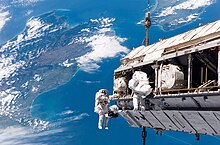
Many changes were made to the originally planned ISS, even before the Columbia disaster. Modules and other structures were cancelled or replaced, and the number of Shuttle flights to the ISS was reduced from previously planned numbers. However, more than 80% of the hardware intended to be part of the ISS in the late 1990s was orbited and is now part of the ISS's configuration.[citation needed]
During the shuttle stand-down, construction of the ISS was halted and the science conducted aboard was limited due to the crew size of two, adding to earlier delays due to Shuttle problems and the Russian space agency's budget constraints.[citation needed]
In March 2006, a meeting of the heads of the five participating space agencies accepted the new ISS construction schedule that planned to complete the ISS by 2010.[6]
As of May 2009, a crew of six has been established following 12 Shuttle construction flights after the second "Return to Flight" mission STS-121. Requirements for stepping up the crew size included enhanced environmental support on the ISS, a second Soyuz permanently docked on the station to function as a second 'lifeboat', more frequent Progress flights to provide double the amount of consumables, more fuel for orbit raising maneuvers, and a sufficient supply line of experimental equipment.[citation needed] As of November 2020, the crew capacity has increased to seven due to the launch of Crew Dragon by SpaceX, which can carry 4 astronauts to the ISS.
Later additions included the Bigelow Expandable Activity Module (BEAM) in 2016, and numerous Russian components are planned as part of the in-orbit construction of OPSEK.[citation needed]
Assembly sequence[]


The ISS is made up of 16 pressurized modules: six Russian modules ( Zarya, Pirs, Zvezda, Poisk, Rassvet, and Nauka), eight US modules ( BEAM,[7] Leonardo, Harmony, Quest, Tranquility, Unity, Cupola, and Destiny), two Japanese modules (the JEM-ELM-PS and JEM-PM) and one European module (Columbus).
The newest module, Nauka, launched 21 July 2021 will become the primary laboratory module on the Russian segment[8][9]
At least one more Russian pressurized module is scheduled to be added to the station.[10] Prichal is a spherical docking node featuring six docking ports.
Although not permanently docked with the ISS, Multi-Purpose Logistics Modules (MPLMs) formed part of the ISS during some Shuttle missions. An MPLM was attached to Harmony (initially to Unity) and was used for resupply and logistics flights.[citation needed]
Spacecraft attached to the ISS also extend the pressurized volume. At least one Soyuz spacecraft is always docked as a 'lifeboat' and is replaced every six months by a new Soyuz as part of crew rotation. Table below shows the sequence in which these components were added to the ISS.[11] Decommissioned and deorbited Modules are shown in gray.
| Element | Assembly flight |
Launch date |
Launch vehicle |
Length | Diameter | Mass | Isolated View | Station View |
|---|---|---|---|---|---|---|---|---|
| Zarya (FGB) | 1A/R | 1998-11-20 | Proton-K | 12.56 m (41.2 ft) | 4.1 m (13 ft) | 24,968 kg (55,045 lb) | 
|

|
| Unity (Node 1) | 2A | 1998-12-04 | Space Shuttle Endeavour (STS-88) | 5.5 m (18 ft) | 4.3 m (14 ft) | 11,895 kg (26,224 lb) | 
|

|
| PMA-1 | 1.86 m (6 ft 1 in) | 1.9 m (6 ft 3 in) | 1,589 kg (3,503 lb) | 
| ||||
| PMA-2 | 1.86 m (6 ft 1 in) | 1.9 m (6 ft 3 in) | 1,376 kg (3,034 lb) | 
| ||||
| Zvezda (Service Module) | 1R | 2000-07-12 | Proton-K | 13.1 m (43 ft) | 4.2 m (14 ft) | 24,604 kg (54,243 lb) | 
|

|
| Z1 Truss | 3A | 2000-10-11 | Space Shuttle Discovery (STS-92) | 
|

| |||
| PMA-3 | 1.86 m (6 ft 1 in) | 1.9 m (6 ft 3 in) | 1,183 kg (2,608 lb) | 
| ||||
| P6 Truss & Solar Arrays | 4A | 2000-11-30 | Space Shuttle Endeavour (STS-97) | 
|

| |||
| Destiny (US Laboratory) | 5A | 2001-02-07 | Space Shuttle Atlantis (STS-98) | 9.2 m (30 ft) | 4.3 m (14 ft) | 14,515 kg (32,000 lb) | 
|

|
| ESP-1 | 5A.1 | 2001-03-08 | Space Shuttle Discovery (STS-102) | 
|

| |||
| Canadarm2 (SSRMS) | 6A | 2001-04-19 | Space Shuttle Endeavour (STS-100) | 
|

| |||
| Quest (Joint Airlock) | 7A | 2001-07-12 | Space Shuttle Atlantis (STS-104) | 5.5 m (18 ft) | 4.0 m (13.1 ft) | 9,923 kg (21,876 lb) | 
|

|
| Pirs (Docking Compartment) | 4R | 2001-09-14 | Soyuz-U (Progress M-SO1) |
4.9 m (16 ft) | 2.55 m (8.4 ft) | 3,838 kg (8,461 lb) | 
|

|
| S0 Truss[12] | 8A | 2002-04-08 | Space Shuttle Atlantis (STS-110) | 
|

| |||
| Mobile Base System | UF2 | 2002-06-05 | Space Shuttle Endeavour (STS-111) | 
|

| |||
| S1 Truss | 9A | 2002-10-07 | Space Shuttle Atlantis (STS-112) | 
|

| |||
| P1 Truss | 11A | 2002-11-23 | Space Shuttle Endeavour (STS-113) | 
|
||||
| ESP-2 | LF1 | 2005-07-26 | Space Shuttle Discovery (STS-114) | 
|

| |||
| P3/P4 Truss & Solar Arrays[13] | 12A | 2006-09-09 | Space Shuttle Atlantis (STS-115) | 
|

| |||
| P5 Truss[14] | 12A.1 | 2006-12-09 | Space Shuttle Discovery (STS-116) | 
|

| |||
| S3/S4 Truss & Solar Arrays | 13A | 2007-06-08 | Space Shuttle Atlantis (STS-117) | 
|

| |||
| S5 Truss | 13A.1 | 2007-08-08 | Space Shuttle Endeavour (STS-118) | 
|

| |||
| ESP-3 | 
| |||||||
| Harmony (Node 2) | 10A | 2007-10-23 | Space Shuttle Discovery (STS-120) | 7.2 m
(24 ft) |
4.4 m
(14 ft) |
14,300 kg (31,500 lb) | 
|

|
| Relocation of P6 Truss |

| |||||||
| Columbus (European Laboratory)[15] | 1E | 2008-02-07 | Space Shuttle Atlantis (STS-122) | 7 m
(23 ft) |
4.5 m
(15 ft) |
12,800 kg (28,219 lb) | 
|

|
| Dextre (SPDM) | 1J/A | 2008-03-11 | Space Shuttle Endeavour (STS-123) | 
|

| |||
| Experiment Logistics Module (ELM) | 4.21 m (13.8 ft) | 4.39 m (14.4 ft) | 8,386 kg (18,488 lb) | 
| ||||
| JEM Pressurized Module (JEM-PM)[16][17] | 1J | 2008-05-31 | Space Shuttle Discovery (STS-124) | 11.19 m (36.7 ft) | 4.39 m (14.4 ft) | 15,900 kg (35,100 lb) | 
|

|
| JEM Remote Manipulator System (JEMRMS) | ||||||||
| S6 Truss & Solar Arrays | 15A | 2009-03-15 | Space Shuttle Discovery (STS-119) | 
|

| |||
| Kibo Exposed Facility (JEM-EF) | 2J/A | 2009-07-15 | Space Shuttle Endeavour (STS-127) | 
|

| |||
| Poisk (MRM-2)[18][19] | 5R | 2009-11-10 | Soyuz-U (Progress M-MIM2) |

|

| |||
| ELC-1 | ULF3 | 2009-11-16 | Space Shuttle Atlantis (STS-129) | 
|

| |||
| ELC-2 | 
| |||||||
| Tranquility (Node 3) | 20A | 2010-02-08 | Space Shuttle Endeavour (STS-130) | 6.706 m (22.00 ft) | 4.48 m (14.7 ft) | 19,000 kg (42,000 lb) | 
|

|
| Cupola | 
| |||||||
| Rassvet (MRM-1)[20] | ULF4 | 2010-05-14 | Space Shuttle Atlantis (STS-132) | 
|

| |||
| Leonardo (PMM) | ULF5 | 2011-02-24 | Space Shuttle Discovery (STS-133) | 6.6 m
(22 ft) |
4.57 m (15.0 ft) | 4,082 kg (8,999 lb) | 
|

|
| ELC-4 | 
| |||||||
| AMS-02 | ULF6 | 2011-05-16 | Space Shuttle Endeavour (STS-134) | 
|

| |||
| OBSS | 
| |||||||
| ELC-3 | 
| |||||||
| CRS SpX-2 | 2013-03-13 | Falcon 9 (SpaceX CRS-2) | ||||||
| BEAM[21] | CRS SpX-8 | 2016-04-08 | Falcon 9 (SpaceX CRS-8) | 
|

| |||
| IDA-2[22][23] | CRS SpX-9 | 2016-07-18 | Falcon 9 (SpaceX CRS-9) | 
| ||||
| IDA-3[24] | CRS SpX-18 | 2019-07-25 | Falcon 9 (SpaceX CRS-18) | |||||
| Bartolomeo[25] | CRS SpX-20 | 2020-03-06 | Falcon 9 (SpaceX CRS-20). | |||||
| Nanoracks Bishop Airlock | CRS SpX-21 | 2020-12-06 | Falcon 9 (SpaceX CRS-21) | 
|
||||
| iROSA[a] | CRS SpX-22 | 2021-06-03 | Falcon 9 (SpaceX CRS-22) | 
|
||||
| Nauka (MLM-U)[26] | 3R | 2021-07-21 | Proton-M | 13 m (43 ft) | 4.25 m (13.9 ft) | 20,300 kg (44,800 lb) | 
|
|
| European Robotic Arm | 11.3 m (37 ft) | 630 kg (1,390 lb) |
- ^ till now only 2 of the 6 iROSAs are delivered to iss
Future elements[]
- In January 2021, NASA announced plans to upgrade the station's solar arrays by installing new arrays on top of six of the station's eight existing arrays.[27]
- Axiom Space plans on launching several modules to connect where PMA-2 is currently at as part of the commercial Axiom Station project. At the end of the ISS's life, Axiom Station could be detached from the ISS and continue in orbit as a commercial low orbit platform.[28]
Cancelled modules[]
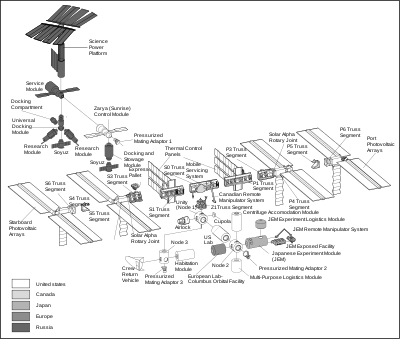
- Interim Control Module – not needed once Zvezda was launched
- ISS Propulsion Module – not needed once Zvezda was launched
- Habitation Module (HAB) – With the cancellation of the Habitation Module, sleeping places are now spread throughout the station. There are two in the Russian segment and four in the US segment. It is not necessary to have a separate 'bunk' in space — many visitors just strap their sleeping bag to the wall of a module, get into it and sleep.
- Crew Return Vehicle (CRV) – replaced by manned spacecraft docked to the station at all times (Soyuz, SpaceX Dragon 2)
- Centrifuge Accommodations Module (CAM) – would have been attached to Harmony (Node 2)
- Nautilus-X Centrifuge Demonstration – If produced, this centrifuge would have been the first in-space demonstration of sufficient scale centrifuge for artificial partial-g effects. It was designed to become a sleep module for the ISS crew.[29]
- Science Power Platform (SPP) – power will be provided to the Russian segments partly by the US solar cell platforms
- Russian Research Modules (RM1 and RM2) – to be replaced by single Multipurpose Laboratory Module (Nauka)
- Universal Docking Module (UDM) – cancelled along with the Research Modules which were to connect to it
- Science Power Module (NEM) – cancelled in April 2021 and used as the core module of the proposed Russian Orbital Service Station (ROSS).[30][31]
Unused modules[]
The following modules were built, but have not been used in future plans for the ISS as of January 2021.
- American Node 4 – Also known as the Docking Hub System (DHS),[32] would allow the station to have more docking ports for visiting vehicles and would allow inflatable habitats and technology demonstrations to be tested as part of the station.[33]
Cost[]
The ISS is credited as the most expensive item ever built, costing around $150 billion (USD),[34] making it more expensive than Skylab (costing US$2.2 billion) [35] and Mir (US$4.2 billion).[36]
See also[]
- List of human spaceflights to the International Space Station
- Uncrewed spaceflights to the International Space Station
- Manufacturing of the International Space Station
References[]
- ^ "4 Astronauts Aboard SpaceX Crew Dragon Successfully Dock With Space Station". www.npr.org. 17 November 2020. Retrieved 16 August 2021.
- ^ "Consolidated Launch Manifest". NASA. Archived from the original on 7 July 2006. Retrieved 15 July 2006.
- ^ Retrieved 15 December 2020
- ^ "What are the ISS attitudes?". NASA. Archived from the original (Flash) on 2 September 2006. Retrieved 11 September 2006.
- ^
Black, Charles (24 December 2012). "When Dragon made commercial spaceflight a reality". SEN. Retrieved 26 December 2012.
[Dragon's] ability to return goods is currently unique because all the other regular supply ships – Europe's Automated Transfer Vehicle (ATV), Japan's HTV (or "Kounotori") and Russia's Progress – all burn up during controlled re-entry.
- ^ Coppinger, Rob (3 March 2006). "NASA commits to Shuttle missions to International Space Station". FlightGlobal. Retrieved 16 September 2006.
- ^ Retrieved 27 November 2017.
- ^ "Russia's Nauka ISS module launches into orbit to dock to the ISS". nasa. July 2021. Retrieved 15 August 2021.
- ^ "Russia's Nauka ISS module arrives at Baikonur for final launch preparations". nasaspaceflight. August 2020. Retrieved 15 August 2021.
- ^ "Russia pressing forward on ISS expansion". nasaspaceflight. July 2019. Retrieved 28 August 2020.
- ^ "Reference Guide to the International Space Station" (PDF). NASA. September 2015. Retrieved 8 June 2019.
- ^ "Space Station Assembly: Integrated Truss Structure". NASA. Archived from the original on 7 December 2007. Retrieved 2 December 2007.
- ^ "P3 and P4 to expand station capabilities, providing a third and fourth solar array" (PDF). Boeing. July 2006. Retrieved 2 December 2007.
- ^ "STS-118 MISSION OVERVIEW: BUILD THE STATION…BUILD THE FUTURE" (PDF). NASA PAO. July 2007. Archived (PDF) from the original on 1 December 2007. Retrieved 2 December 2007.
- ^ "Columbus laboratory". ESA. 10 January 2009. Archived from the original on 30 March 2009. Retrieved 6 March 2009.
- ^ "About Kibo". JAXA. 25 September 2008. Archived from the original on 10 March 2009. Retrieved 6 March 2009.
- ^ "Kibo Japanese Experiment Module". NASA. 23 November 2007. Archived from the original on 23 October 2008. Retrieved 22 November 2008.
- ^ Zak, Anatoly. "Docking Compartment-1 and 2". RussianSpaceWeb.com. Archived from the original on 10 February 2009. Retrieved 26 March 2009.
- ^ Bergin, Chris (9 November 2009). "Russian module launches via Soyuz for Thursday ISS docking". NASASpaceflight.com. Archived from the original on 13 November 2009. Retrieved 10 November 2009.
- ^ "NASA Extends Contract With Russia's Federal Space Agency" (Press release). NASA. 9 April 2007. Archived from the original on 23 June 2007. Retrieved 15 June 2007.
- ^ "NASA to Test Bigelow Expandable Module on Space Station". NASA. 16 January 2013. Retrieved 16 January 2013.
- ^ Jason Rhian (18 July 2016). "SpaceX Conducts Second Ground Landing After Launch Of CRS-9 Dragon To ISS". Spaceflight Insider.
- ^ Harwood, William (19 August 2016). "Spacewalkers attach docking adapter to space station for commercial vehicles". Spaceflight. Retrieved 20 August 2016.
- ^ "Spacewalkers Complete Installation of Second Commercial Docking Port – Space Station". blogs.nasa.gov.
- ^ "Successful launch for Airbus' Bartolomeo". Airbus (Press release). 9 March 2020. Retrieved 4 January 2021.
- ^ "FGB-based Multipurpose Lab Module (MLM-U)". Khrunichev State Research and Production Space Centre. Archived from the original on 27 September 2007. Retrieved 31 October 2008.
- ^ "NASA to upgrade space station solar arrays". SpaceNews. 12 January 2021.
- ^ "Axiom Commercial Space Station". Axiom Space.
- ^ "Nautilus X Holderman - 1 26 11 | PDF | Flight Controller | International Space Station". Scribd.
- ^ "Научно-энергетический модуль запустят на "Ангаре" с Восточного" [The Science Power Module will be launched on an Angara from Vostochny]. Roscosmos (in Russian). 24 April 2021. Retrieved 26 April 2021.
- ^ Zak, Anatoly (16 April 2021). "Russian Orbital Service Station, ROSS". RussianSpaceWeb. Retrieved 26 April 2021.
- ^ Harding, Pete (20 December 2010). "ISS Managers review long-term configuration of International Space Station".
- ^ "Spaceflight Now | Breaking News | Test article could facilitate space station applications". spaceflightnow.com.
- ^ "Is The International Space Station The Most Expensive Single Item Ever Built?". Science 2.0. 27 August 2014. Retrieved 3 May 2018.
- ^ "The Space Review: Costs of US piloted programs". www.thespacereview.com. Retrieved 3 May 2018.
- ^ Tyler, Patrick E. (24 March 2001). "Russians Find Pride, and Regret, in Mir's Splashdown". The New York Times. ISSN 0362-4331. Retrieved 3 May 2018.
External links[]
- Animated ISS assembly process, mission designations and dates are included.
- Diagram of planned components of the ISS, positions of cancelled modules can be seen.
- Media articles
- International Space Station
